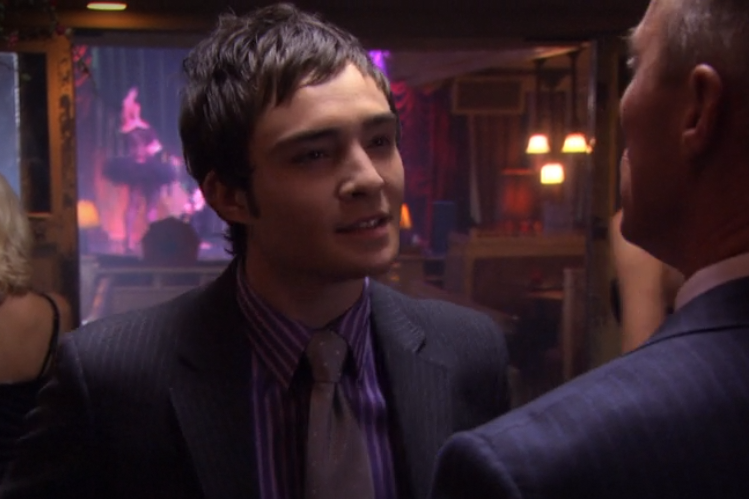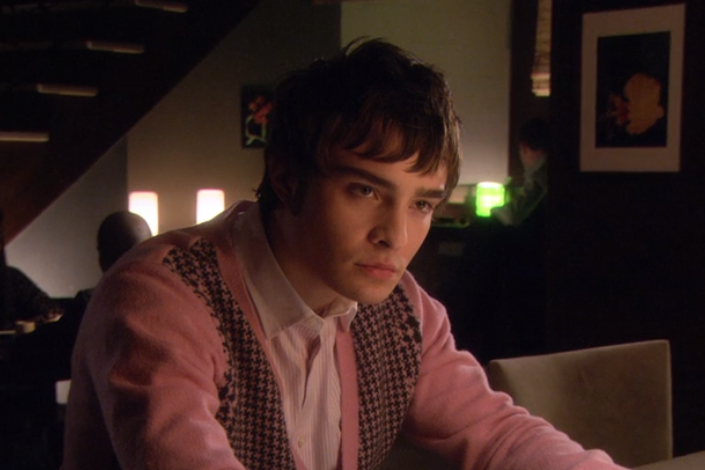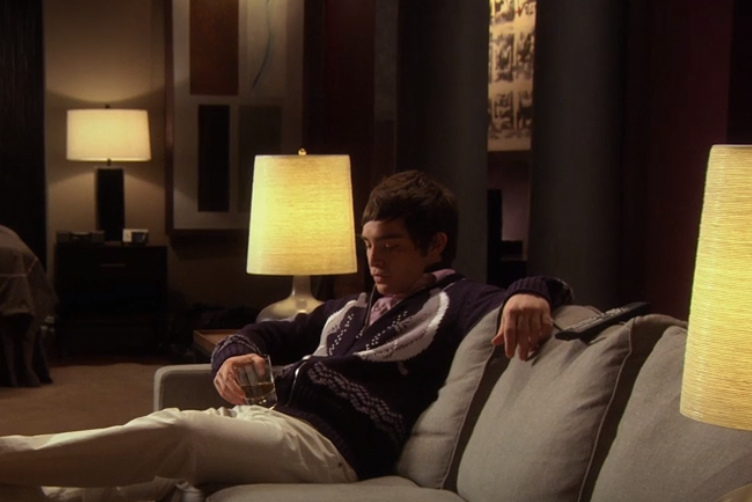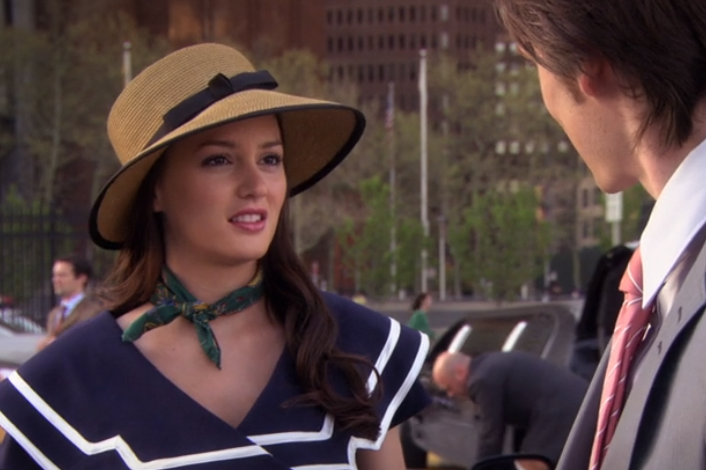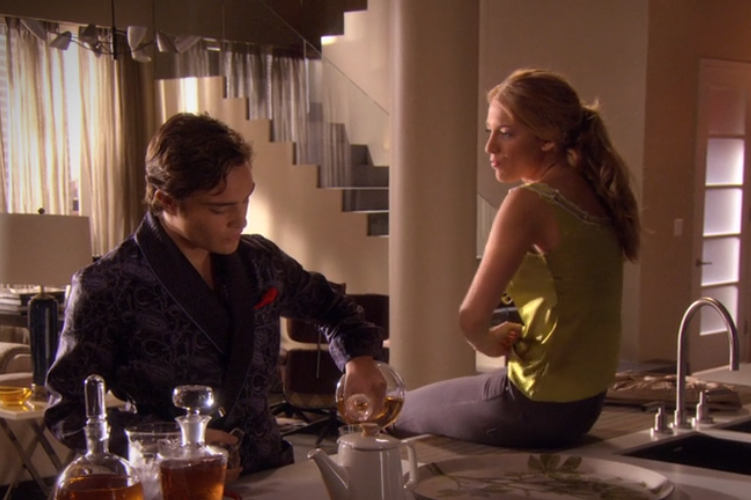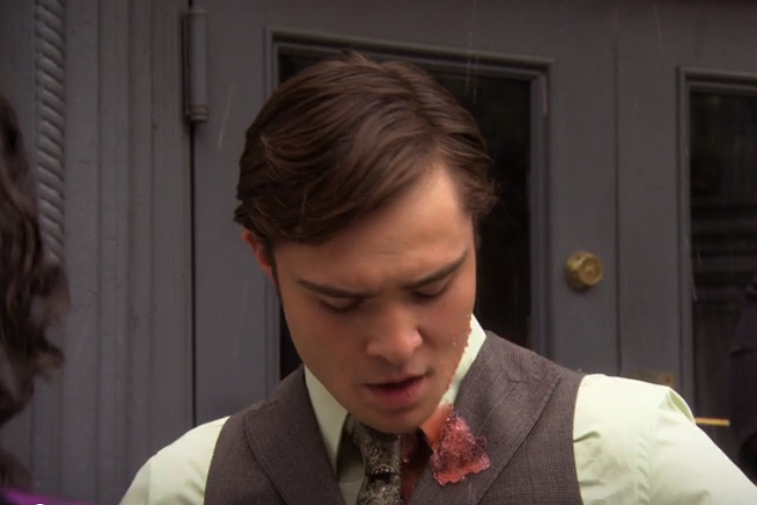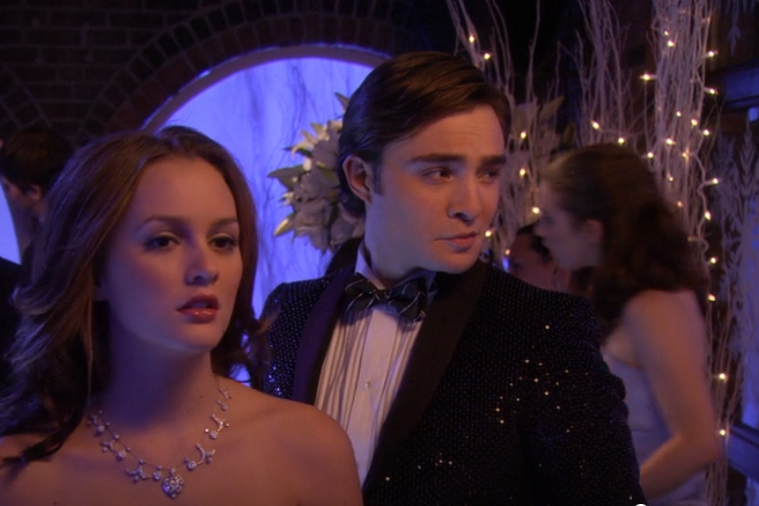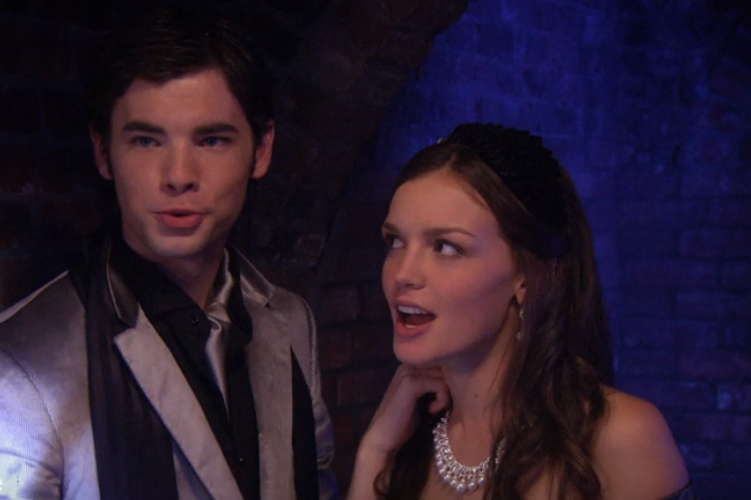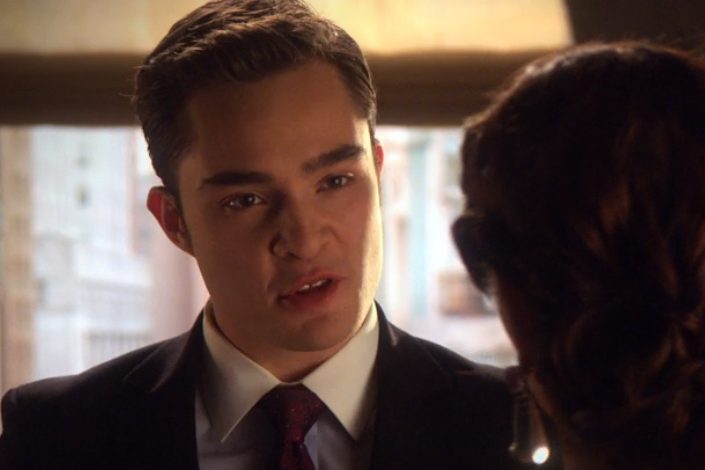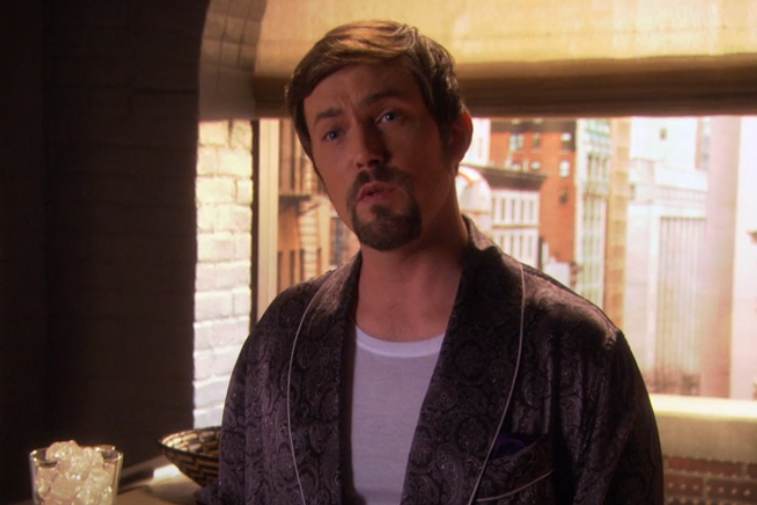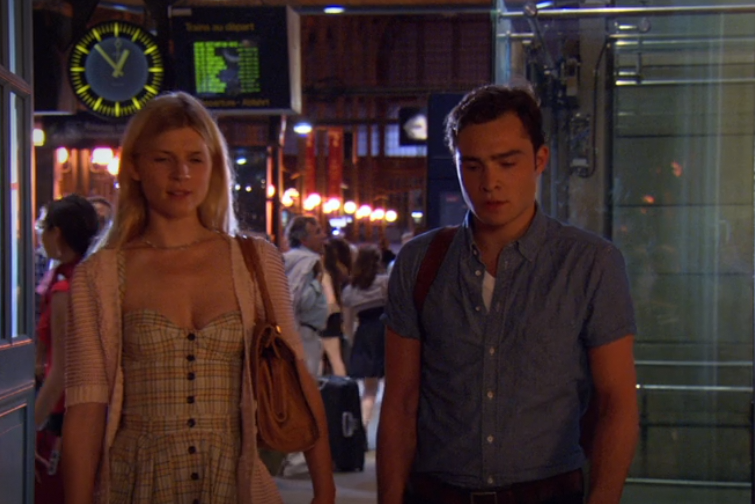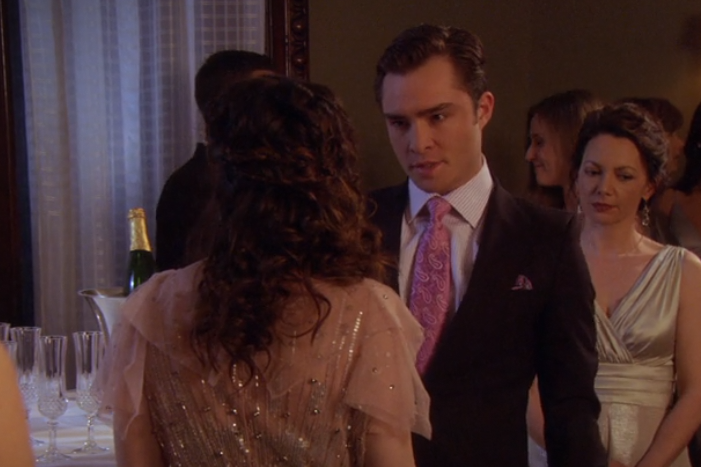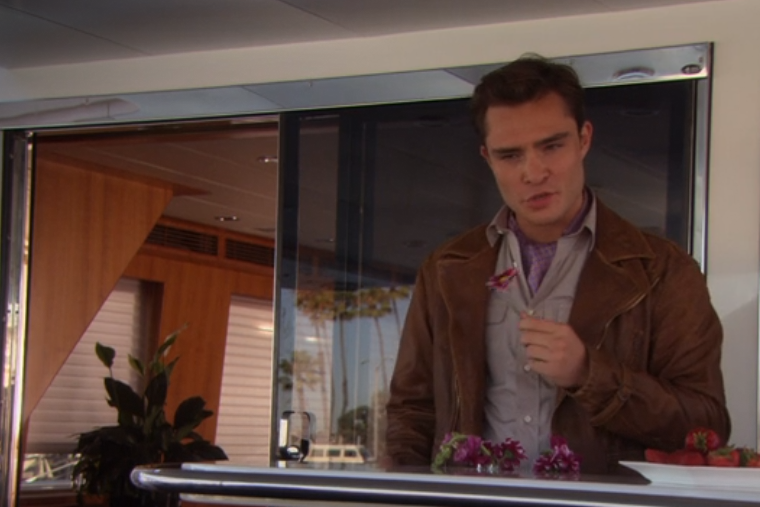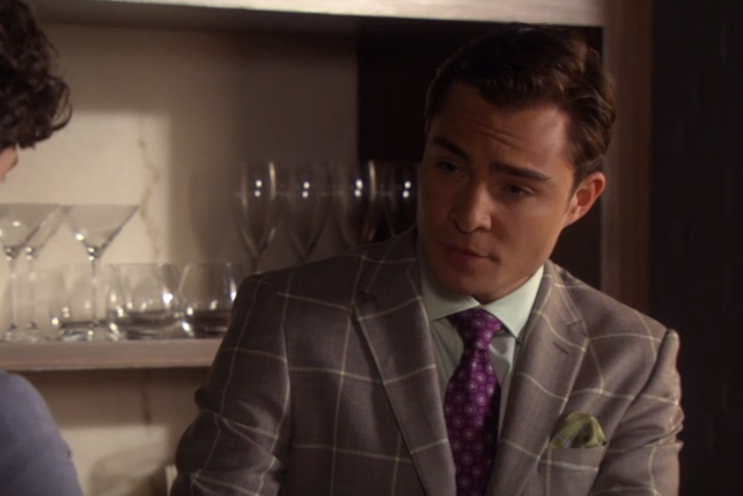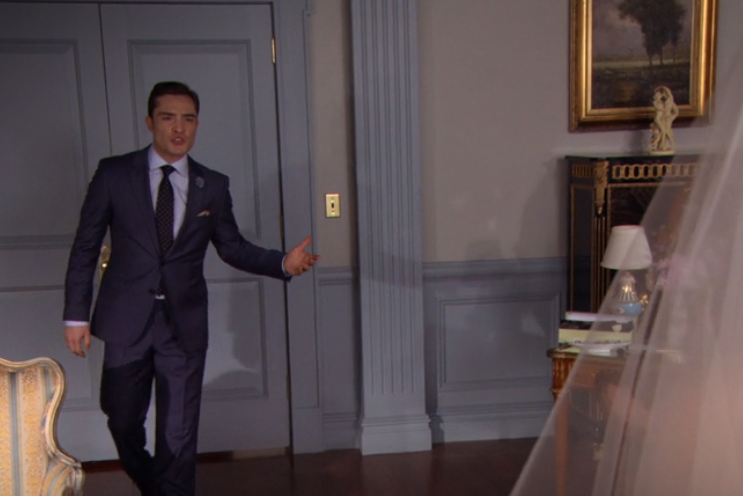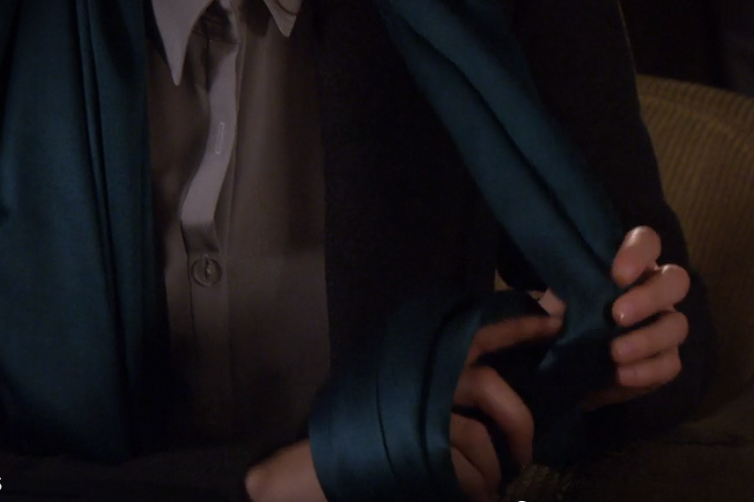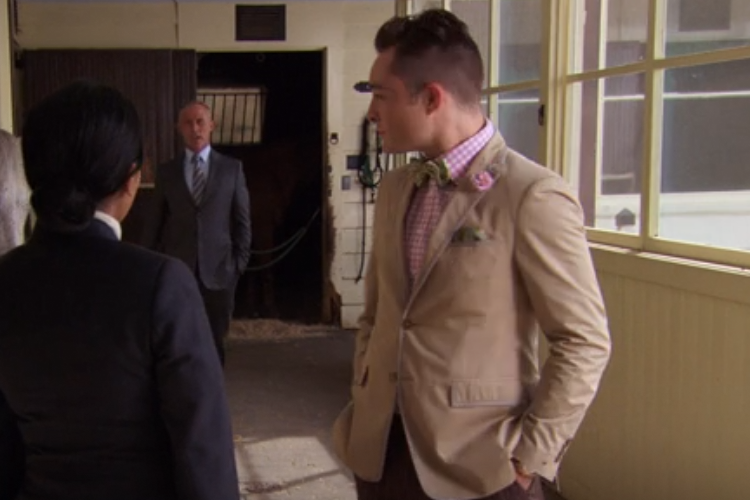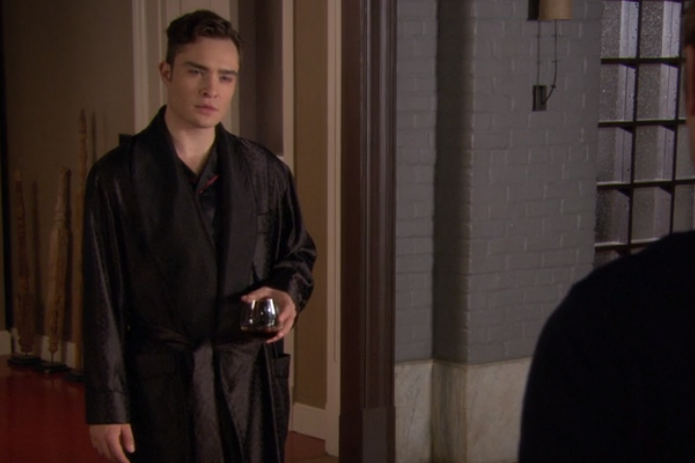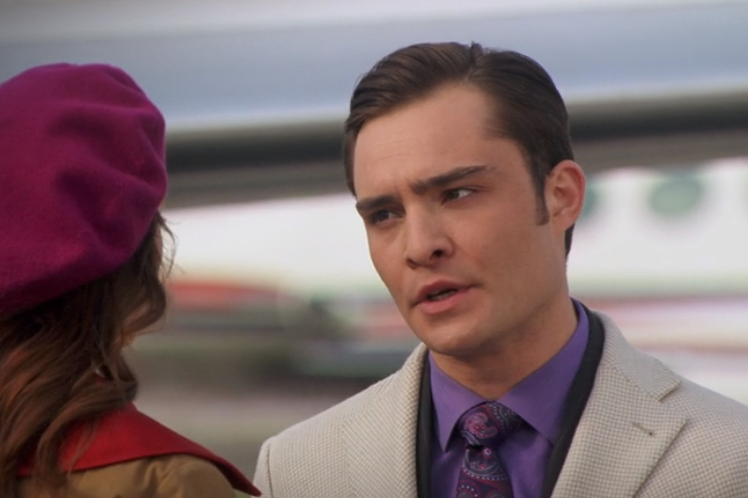The Romanticizing of Chuck Bass
Originally published on Substack 5/13/2021
[This profile contains discussion of abuse and sexual assault.]
Chuck Bass is sometimes framed as an unlikely leading man. In an interview with Vulture midway through the fourth season, executive producer Stephanie Savage said, “If you think about Chuck Bass in the pilot, you wouldn’t go, ‘Oh, that’s probably a character that’s going to have big “A stories” in season four.’” And yet, looking back on the series as a whole, the rise—and the romanticizing—of Chuck Bass seems almost inevitable. He’s the latest in a long line of romantic antiheroes: Mr. Rochester and Rhett Butler and Heathcliff, brooding men whose mysterious, tragic backstories go hand-in-hand with their violent, abusive behavior (like, off the top of my head, locking a wife in the attic or leading a KKK raid or just generally being a little piss baby). And of course, a romantic antihero must always have his heroine: Jane Eyre or Scarlett O’Hara or Catherine Earnshaw—or in Chuck’s case, Blair Waldorf. (In season three, Blair even remarks that she and Chuck “played Wuthering Heights” in one of her dresses.)
I think it’s important to dissect the appeal of Chuck Bass because I (like many other viewers) was once a fan of Chuck and, more important, Chuck and Blair—until I realized, in season three, how abusive and twisted their relationship had become. I was also a teenage girl, the show’s target audience. For a teenage girl, or at least this teenage girl, the allure of Chuck lay not just in his tragic backstory, in an idealized, Coldplay-fueled desire to “fix” a romantic partner, but in his wealth, his sexual confidence. He can buy whatever he wants; he’s not ashamed of having or talking about sex (in fact, the show loves to remind us, he’s good at it—at least when it’s consensual). As a rich white cis boy, he is free in a way most teenage girls are not allowed to be.
Not only that, but Chuck can wear whatever he wants. He loves fashion and never dismisses it as something feminine or silly. Rather, Chuck is the show’s “urban dandy” (“Gossip Girl Couture”), more adventurous in his dressing than Dan Humphrey or Nate Archibald. (To be fair, it is easier to “wear whatever [you] want” when you’re the “richest boy in New York City,” as head costume designer Eric Daman puts it (“5 Years of Iconic Style”). Money gives you the ability to replace your fancies if they don’t work, the ease of being driven everywhere in a limo, thus avoiding inclement weather.)
Like his central love interest, Blair, Chuck favors preppy staples and bows and bold colors—from popped-collar polos in season one to full business suits and neckties in later seasons. The evolution of Chuck’s look, however, is always tied to a different character: his emotionally abusive father, Bart Bass. Bart is a self-made real estate mogul, his boldest fashion choices being pinstriped suits and banker’s collars, and so Chuck uses his own clothes to either rebel against or emulate his father. He may share a color palette with Blair, but the function of his clothes and story lines always, always goes back to Bart.
Season One
First, let’s clarify what Savage meant by “Chuck Bass in the pilot.” The Vulture interviewer certainly tried to, asking if the writers would’ve made Chuck an “attempted rapist” in the first episode if they’d known how central the character would become later on. In her reply, Savage helpfully explains that Chuck is actually an “attempted kissing bandit,” as if forcing his mouth on and trying to pin down both Serena van der Woodsen and Jenny Humphrey was not meant to go further or at least threaten that possibility. Doesn’t the word “bandit” imply something illicit, an unwanted taking?
The morning before Chuck assaults Serena, he tells his best friend, Nate, that “[her level of perfection] needs to be violated”—a statement, I should note, that Nate finds disturbing. For that is the show’s push and pull with Chuck: based on the other characters’ reactions, the show seems to know that Chuck’s behavior is wrong, but the show also seems to take some strange, leering pleasure in that, in Chuck waking up with two Palace hotel employees and telling them, “I’ll be sure to tell my father just how committed you are to the hospitality industry” (1.2). (To be fair, the power imbalance is off on both sides: Chuck is a teenager at the time and the employees are likely older. Even more disturbing, Chuck references sexual experiences with a childhood nanny at least once, suggesting that he has been taught fucked-up ideas about consent from a young age.)
His father owns the Palace, where Chuck has his own suite of rooms and Bart is hosting his foundation’s annual brunch. Chuck attends in a white suit, pink-and-white-striped button-down, and yellow striped bowtie, in sharp contrast with his father’s dark pinstriped suit, blue button-down, and striped necktie. In the first couple seasons, Chuck rarely wears neckties like his father, choosing less businesslike neckwear instead: bowties and ascots and his “signature” scarf. The scarf, funnily enough, is a patchwork of “leftover tie pieces” (“Couture”), almost as if Chuck is dismantling his father and all he represents.
Bart is embarrassed by Chuck’s womanizing and drinking and general debauchery—at the brunch, represented by his black eye, glass of scotch, and playful wardrobe. He wants his son to behave more seriously, to take an interest in his business. “This party is for you, so you can meet people,” Bart tells Chuck.
Unlike Nate or Dan, who wear standard-issue yellow button-downs with their St. Jude’s uniforms, Chuck often pairs a polo or striped shirt, even a sweater vest or plaid waistcoat, with his khakis, red-and-gold tie, and navy blazer. In episode 1.3, for example, he chooses a yellow polo, the collar popped. Chuck’s uniform experiments link him to the more fashion-forward female students, like Blair, who push the boundaries of their uniforms.
Blair has long been dating Nate, but she goes to Chuck when she has a scheme in mind. Chuck, in turn, shares his business plans with her. He wants to buy a burlesque club, the Victrola, but must get his father’s approval on his proposal (1.7). For his meeting with Bart, Chuck chooses a pinstriped suit, striped shirt, and polka dot necktie; the pieces all business but the shirt still in one of Chuck’s favorite colors, purple. Bart himself is stiff in a white shirt, gray striped tie, and dark pinstriped suit—fitting, as Chuck tells him the club is the “perfect way . . . to loosen the top button of Bass Inc.”
Bart agrees to visit Victrola, delighted that Chuck is finally interested in his business. When he arrives, however, he sees Chuck kissing an employee and decides the club is just another excuse for his son to booze and womanize. “You want to impress me with your commitment to something?” he tells Chuck. “Try getting a few A’s in school or maybe a part-time job.”
Chuck watches his father, who has recently become monogamous with Lily van der Woodsen, leave in a limo with another woman. Drunk and upset, Chuck tells Lily what he saw, not realizing that the woman is actually a New York Observer reporter, Pauletta Cho, who wants to get into real estate. She encourages Bart to take Chuck’s proposal seriously, and he decides to take a tour of the club.
Bart is yet again in a pinstriped suit, striped tie, and button-down, but Chuck has returned to his bowtie, this time with a pale blue shirt and three-piece black suit. He didn’t think he’d get a second chance with his father, and so he quickly abandoned his business wear for his usual dandy wardrobe. Bart leaves after learning Chuck almost ruined his relationship with Lily, and then Blair arrives. She and Nate have just broken up, and she wants to escape through the Victrola—and ultimately, through sex with Chuck in the back of his limo.
Chuck likes Blair, but instead of expressing his feelings, he manipulates both Nate and Blair into not getting back together (1.8). He even makes a bet with Blair that Nate won’t call her on her birthday: if he’s wrong, he’ll leave her alone; if he’s right, she has to spend the night with him. When Nate doesn’t call, Chuck apologizes and offers his birthday gift: a big diamond necklace. It’s appropriately Freudian that Chuck is wearing a pinstriped suit in this scene, even if it is paired with a pink shirt and ascot. Bass men love gifting expensive necklaces almost as much as they love wearing ties: see, for example, the necklaces Bart gives Lily in seasons two and six. The “nape of the neck,” Blair later says, is “Chuck’s kryptonite,” so of course he would favor a present that fastens just there.
Chuck and Blair secretly have sex until cotillion, when Chuck unintentionally facilitates Blair finally sleeping with Nate (1.10). Again, Chuck won’t just tell Blair that he likes her and instead blackmails her into avoiding Nate (1.12).
Blair and Nate begin dating again in episode thirteen, and Chuck watches them canoodle at school, a moody look on his face. With his uniform, he wears a brown tweed newsboy cap, plaid waistcoat, and gloomy black trench—but, interestingly enough, no visible scarf. Much like Blair loses her headband when she feels powerless, Chuck seems to lose his scarf when he feels the same.
Out of revenge, Chuck sends a tip to Gossip Girl, revealing that Blair slept with him and Nate in the same week. Chuck loses Nate’s friendship, but Blair loses everything: her boyfriend, her reputation, her friends—even Chuck.
“You held a certain fascination,” he tells her, “when you were beautiful, delicate, and untouched. But now you’re like one of the Arabians my father used to own. Rode hard and put away wet. I don’t want you anymore and I can’t see why anyone else would.” In this scene, Chuck wears a pink houndstooth cardigan over a pink striped button-down: the color strangely soft for such a hard, cruel statement. Still, the color pink often symbolizes femininity and, especially, female sexuality, and so it’s fitting that he’s wearing the color to weaponize Blair’s sexual history against her. His neck, too, is bare—no necktie or bowtie that would connect him to his father or Blair, just unmasked disdain for them both.
Chuck’s story quickly shifts to a new development in his life: Bart and Lily are engaged, and the Basses and van der Woodsens are moving in together. Bart names Chuck his best man and expects the best behavior in return; he even offers to invest more money in the Victrola. Try as Chuck does to behave, he still gets blamed for sending prank gifts to Serena. Bart kicks him out of the penthouse and back into his old Palace suite (1.14).
When Serena learns her old frenemy Georgina is responsible for the “gifts,” she goes to Chuck. He’s dressed, naturally, in a fish-print navy sweater, pink striped shirt, and khakis. Yet again, no tie to connect him back to Bart, but the sweater speaks loudly enough: Chuck still desperately wants to be seen as a real Bass by his father, even if it’s only through kitschy knitwear.
Chuck reunites with Nate and Blair to take down Georgina (1.17), thus renewing his friendship with Nate and rekindling his romance with Blair. The Bass wedding is fast approaching, Chuck wearing, yes, blue plaid pants and a tan cardigan but also a blue banker’s collar shirt and yellow striped necktie. His palette picks up the colors of Blair’s yellow dress and Nate’s blue sweater, while the banker’s collar and necktie remind us of Bart, who is wearing a white collar that very same episode.
To the rehearsal dinner, Chuck wears a black suit with a red bowtie and white shirt, its plaid muted. His look is miles away from the splashy white suit he wore to brunch—he’s trying to be “good” for his father, toning down his usual bold colors and wild prints.
At the wedding (1.18), Chuck is equally restrained, though still coordinated with Blair. Or, should I say, she’s coordinated with him. After all, Chuck is the best man and must wear a black suit, white shirt, and pink floral bowtie like the other groomsman, Eric van der Woodsen. Blair dresses toward Chuck’s look, choosing a pink floral dress and matching headband.
Halfway through his best man toast, Chuck lays aside his note cards, the rest of his speech inspired by Blair. Bart’s relationship with Lily, he says, taught him that “in the face of true love, you don’t just give up, even if the object of your affection is begging you to.” While the speech is framed as a romantic gesture to Blair, it’s really more a summary of the Chuck Bass playbook: push your partner’s lines of consent, and if they don’t give, manipulate or trample them. “[Lily] gave [Bart] the gift of a second chance,” Chuck continues, “and in kind I’ve watched him become someone worthy of that gift. And one day . . . I hope I’ll be lucky enough to find someone who will do that for me.”
Blair is willing to give Chuck that second chance, especially after he apologizes for comparing her to Bart’s “sweaty horses.” He’s planning to take her to Europe in the Bass private jet, Blair all ready for a summer jaunt in a sailor-inspired dress and straw hat. Chuck, however, is somewhere back in the spring—a plaid sweater vest, yellow button-down, and khakis. Before Chuck leaves for the jet, Bart tells him how proud he is: “You really are growing up.
Chuck brushes off his compliment: “[Blair] knows I’ll never change.”
“Yeah, until you take her away to Europe on a private jet,” Bart says. “That is going to change everything. But that’s a good thing, son. Having a real girlfriend will force you to learn about responsibility, sacrifice, being faithful, taking account of somebody else’s feelings, not just your own. . . . You will come back from this summer a new man.”
Chuck finally has his father’s respect, a relationship with Blair, and so he immediately torpedoes both. He leaves Blair alone on the tarmac and hits on Lily’s new interior decorator, offering her a red rose intended for Blair along with his catchphrase: “I’m Chuck Bass.”
Season Two
Chuck spends the summer being Chuck Bass, only in the Hamptons. When Blair returns from Europe, he meets her at the jitney, a bouquet of yellow roses in hand. Chuck obviously never learned flower language, because yellow roses mean friendship—and he’d be lucky to get that. Blair has brought home a new boyfriend, James, to make Chuck jealous.
Chuck’s Hamptons style is even brighter and more playful than his city style—free from the sobering influence of Bart, who is on his honeymoon with Lily. To dinner, he wears a mint-green suit, pink polka-dot shirt, and blue-green bowtie. He grills James about Blair, only stopping when he sees her heart-shaped pin on her new beau’s sweater—the same pin, he knows, that she gave to Nate when she told him she loved him. When he asks Blair if she loves James as much as she loved Nate, she lies and says yes. Their conversation—his green suit and her green floral dress on a lush green lawn—is one of the most beautifully framed shots on the show.
In truth, Blair and Chuck love each other, but neither can be vulnerable enough to admit it. Blair asks Chuck to say, “I love you,” and when he can’t, she leaves with James (who is actually an English lord named Marcus! I know, we can’t get into it now).
By episode three, Chuck is back at the penthouse, but his libido hasn’t come with him. He’s trying everything for his impotence, and yet Serena quickly diagnoses Chuck’s problem—“It’s just so obvious. You’re not over Blair”—and unintentionally gives him the gross idea to use Blair as “sexual Drano.”
This scene is the first appearance of Chuck’s favorite loungewear, a smoking jacket. This one is blue paisley with a red pocket square, though other colorways pop up throughout the series. He often wears the jacket while hanging around his penthouse, sometimes postcoital. It’s formal yet louche, evocative of its most famous proponent, Hugh Hefner.
Bubble Episode
Chuck doesn’t sleep with Blair, though he does dethrone her as queen bee—bringing us to this profile’s bubble episode, “The Serena Also Rises.”
At the beginning of the episode, Chuck offers to be Blair’s “ally” against the new queen, Serena. After Blair rejects him, he delights in her failed attempt to reclaim her crown, only to be quickly dressed down by the furious Blair. “There’s a reason you’re always [at school] alone,” she tells him. “Nate’s only friends with you out of habit. The only person with fewer friends than you is Dan Humphrey and at least his lame nineties dad likes him. And that’s because he’s something that you’ll never be: a human being.”
In this scene, Chuck pairs his uniform pieces with his scarf and a blue striped button-down—an unusual color choice, as Chuck usually sticks with standard yellow. Blue reminds us of blue-eyed Nate and Bart, who both frequently wear the color. The final twist of Blair’s knife was evoking Dan’s dad, implying that even Chuck’s own father doesn’t like him.
Lucky for Chuck, Dan is looking for new material for his short stories and asks Chuck to take him along on his adventures. Chuck agrees—seeing, perhaps, a chance for companionship or at least “amusement.” He brings Dan to a bar, pressures him into shots and pills, and then kicks him, wasted and shoeless, out of his limo.
On this first night, Chuck is dressed in a roguish mix of his father and himself, a jaunty juxtaposition between a navy banker’s collar shirt, unbuttoned at the neck, and a striped blue neckerchief. Later, he throws a blazer on top.
The next night, Dan tries again, pushed by his writing mentor to find his “character’s” secret. At the bar, he overhears Chuck on the phone with his father—the conversation cut short by Bart, who makes no time for his son. “[My father is like] me,” Chuck tells Dan, “only older and meaner.”
This time, Chuck is wearing a gray suit with white piping, white button-down, and black necktie embroidered with skulls. There’s none of Chuck’s usual color or whimsy in this outfit, only the reminder of his father in the necktie, the little skulls warning danger ahead. After Dan punches a man in Chuck’s defense, they both end up in jail. There, Chuck thanks him, even opens up enough to let out his biggest secret, the root of his tragic backstory: “My father doesn’t care enough to get angry. He expects this. He’ll be annoyed that he has to call his lawyer. . . . [He’s been like that] since the day I was born. . . . His beloved wife died giving birth to me. . . . Sometimes I swear he thinks I killed her.”
Chuck offers to have Dan released into his lawyer’s custody, but then the police accidentally give him his new friend’s possessions—among them, a marked-up story about a boy named “Charlie Trout.” Chuck leaves Dan in the cell, telling him that he made up the story about his mother. She died in a plane crash when he was six, he says, but he’s too late, both for Dan and the show itself. Now all of Chuck’s behavior, past, present, and future, must be filtered through the lens of his dead mother and punishing father.
In episode six, Chuck visits Yale’s campus. He’s evaluating colleges based on their secret societies, and the Skull and Bones is a not-so-secret option. The Skull and Bones members ask Chuck to prove his loyalty by offering up Nate for humiliation, but he gives them Dan instead. He’s again wearing a gray suit, white shirt, and red bowtie embroidered with little skulls—both showing his affiliation with the society and calling back to the previous episode, when Dan betrayed him.
Still, Chuck’s plot backfires: when Nate finds out what he did, he decides he’d rather be friends with Dan. In the next episode, Blair asks Chuck to seduce Dan’s friend Vanessa Abrams as revenge, the prize being sex with Blair. At first, Chuck pretends to be interested in buying the Brooklyn bar that Vanessa is trying to get landmarked, but as the episode goes on, he becomes more invested in the bar and Vanessa herself. He meets the bar’s owner, Horace, a magical Black man who tells him about the days Joe Kennedy used to frequent the bar. “Rumrunner, womanizer, millionaire, he was my kind of guy,” says Chuck, and then I roll my eyes so hard that they fall out of my head.
And yet, this episode does show a new side of Chuck. When he first visits the bar, he wears a double-breasted gray vest and pants, a pale green shirt and paisley necktie—a little bit dandy and a little bit business. One of the bar’s supporters throws fruit at him, and Horace makes fun of his outfit, perhaps the first time we’ve seen his clothes ruined, his appearance critiqued. “Chuck Bass” doesn’t mean much in Brooklyn, and so he must work harder to gain Horace’s and Vanessa’s confidence and respect.
Bart shoots down the idea of buying the bar, even after Chuck says that the supporters are counting on him. “Luckily, letting people down is your forte,” Bart replies. Even when Chuck does want to become more accountable, more serious, his own father can’t accept that he can change.
After Blair reveals their bet to Vanessa, Chuck turns the table on Blair, asking her to say, “I love you.” When she refuses, he tells her, “I chased you for long enough. Now it’s time you chased me.” Blair does, for an episode, but neither can bring themselves to say those magic words, to pull them out from under years of distrust and manipulations. “I think we both know the moment we [say “I love you”],” says Chuck (2.8), “it won’t be the start of something, it will be the end. . . . What we like is [the game].”
Chuck turns his attention back to his father, buying them a Rangers skybox for Bass Industries’ twentieth anniversary (2.10). Bart rejects Chuck’s attempt at father-son bonding, though he seemingly has enough time for Dan to shadow him. Dan is secretly writing a profile of Bart for New York magazine, and he’s just learned that Bart set fire to a building for insurance money in 1987.
Chuck uncovers the profile and interrupts Bart and Dan just as Bart reveals that the fire killed a security guard. In this scene, Chuck wears a navy-and-red argyle sweater with a pink button-down, white-blue-and-red-checked necktie, and gray slacks. He shares the same red-white-and-blue color palette as his father, and of course the necktie always ties back to Bart. Chuck begs Dan not to publish the story: “It will ruin our family.”
Instead, Dan sends his story about Charlie and “Bernie” Trout to Bart. After reading it, Bart goes to Chuck, says he doesn’t blame him for his mother’s death: “It’s just hard because every time I look at you, I see her.” The camera lingers on a black-and-white photo of Chuck’s mother, which, considering the show’s later story lines, I can only assume came with the frame. Bart invites Chuck to a Rangers game, and for this moment at least, they’re at peace with each other.
In episode eleven, however, Chuck shows his stepbrother, Eric, how to open his father’s safe, and they discover that Bart had a PI investigate his family members. Lily knows that Bart has a file on her, but when she learns he has files on her children, they separate. Bart, unsurprisingly, blames Chuck for his broken marriage: “Every time I think we’re making progress, you show your true colors.”
Just before Christmas, Chuck attends the annual Snowflake Ball in a beautiful black sequined tux—almost as if snow has dusted him—and a black-and-silver striped bowtie. He and Blair have agreed to choose each other’s dates, and each ends up bringing a knockoff version of themselves. Chuck’s date for Blair, for example, wears a cheap-looking silver tux with a black shirt, silver ascot, and—what else?—black scarf. Their knockoffs end up being more interested in each other, leading Chuck and Blair to wonder why they can’t make it work.
At the ball, Chuck sees Lily talking with her longtime love, Rufus Humphrey, and says she owes his father “a conversation.” He calls Bart, tells him to come to the ball, but on the way, the car crashes and Bart “dies.”
Chuck spends the days leading up to the funeral in his Palace suite. When he emerges, he looks more disheveled and muted than we’ve ever seen him. (His pale foundation alone would make the Twilight makeup artist say, “Too much.”) Chuck’s black pinstriped suit, black button-down, and gray necktie symbolize his father and his grief, but the purple handkerchief that peeps out from a pocket shows that there’s still a glimmer of the old Chuck inside.
Before the funeral, Chuck meets with his father’s PI, who gave Bart some information about Lily before his death. Chuck wants to know what it was, but the PI thinks he might have a bidder in Lily, too. Chuck blames Lily, blames Rufus, blames really anyone but himself for Bart’s death, perhaps to avoid the horrible thought that his call to Bart led to the accident. (Ed Westwick simply gobbles the scenery at the funeral, delivering such beautiful lines as “Don’t touch me, whore!” and “My family? I don’t have a family!”) Blair does her best to take care of Chuck, but he rejects even her and her long-awaited admittance: “I love you.”
Chuck is the only bidder for Lily’s secret, and he taunts her with the evidence. He’s still all in gray and black—plaid blazer, sweater, striped shirt—but his clothes are a little neater, a sign that Chuck is coming back to himself.
“Please don’t turn away from the people who love you,” Lily says. “They’re the only chance any of us has. Your father never learned that. I hope that you do.” Briefly, Chuck does—burning the papers and going to Blair for comfort. Then he leaves again, and somehow ends up in Bangkok, at what looks to be an opium den. I think there’s a whole other essay that could be written on the show’s exoticizing and stereotyping of non-white cultures and women to make Chuck seem “darker” and more deviant, but needless to say, this (or the Japanese flight attendant in 2.3 or the Brazilian triplets in 2.1) is an example.
Bart’s younger brother, Jack, brings a wasted, rumpled Chuck back to the city (2.14). Chuck attempts to go to school, but even his uniform is half-assed: a brown tweed jacket and yellow sweater barely imitating the usual navy blazer and yellow button-down. He smokes hash in the school courtyard and, after Blair justifies his actions to their headmistress, lights up again inside. Chuck’s behavior, certainly, is a product of his loss, but it’s hard to believe his nastiness toward Blair and other characters is entirely grief fueled when he’s acted like an asshole this whole time. Chuck believes he’s living up to Bart’s worst idea of him, only shaken when he learns that his father has left him a majority share in Bass Industries.
To the will reading (2.15), Chuck wears a gray tweed suit, blue checked shirt, and striped red necktie, almost as if he’s doing Bart cosplay. Bart left him a letter, and Chuck guesses at its contents: “You’re a disappointment of a son. I’d die of embarrassment if I wasn’t already. Why do you wear so much purple?” And yet, the letter says that Bart believes in Chuck, that he thinks he’s prepared him for this role.
At Blair’s encouragement, Chuck decides to accept the share, but Uncle Jack wants it for himself. He sabotages Chuck’s first introduction to the Bass board members, taking them to a Chuck surrounded by sex workers and drug paraphernalia, his checked shirt undone, his red tie and suit jacket gone. Turns out, Bart included a morality clause, and the board replaces Chuck with his legal guardian, Jack. Defeated, Chuck tosses his red necktie alongside a photograph of his father—who’s wearing the exact same tie.
In the next episode, Chuck asks Lily for help removing Jack, though quickly turns on her again when he overhears her talking with Rufus. “You say you want to be family,” he says, “but if you really meant it, you wouldn’t parade your mistress in public. You’d have some tact, some respect. I should have known from your history.” As much sexual history as Chuck has, as changeable as he can be with his own love interests, he doesn’t make those same allowances for a woman like Lily.
Lucky for him, she still knows how to save him: before Bart died, she was planning to adopt Chuck; all she has to do is sign the papers and she’ll become his legal guardian, not Jack. When Jack finds out, he attempts to rape Lily in a bathroom before Chuck breaks the door down. This scene, I think, is meant to be redemptive for Chuck: the former attempted rapist stopping a rape, as if the recognition of rape is somehow a cure from doing it again, another woman’s trauma the balm for a man’s misbehavior. And yet, Chuck’s own assaults aren’t mentioned until five episodes later (2.21).
Lily and Rufus’s relationship is quickly growing more serious, and the Humphreys will soon move in to the Bass/van der Woodsen penthouse—much to Jenny’s chagrin. After Chuck almost ruins her date, she confronts him, telling him he’s lucky she never told her dad about the assault. It’s the first and only time Jenny expresses her rage over her assault, the first time Chuck is confronted with the ramifications of that night. He’s dressed simply in this scene, none of his usual fripperies: a white-and-gray-striped button-down, gray vest, and black pants.
The vest I find most interesting, because it’s a piece more commonly worn by Dan and Serena, the two characters who interrupted Jenny’s assault. Is it meant to show Chuck as an ally, not an aggressor? Later that evening, Chuck apologizes to Jenny and says he’ll move out if she moves in. While he does make good on this promise in season three, I think this apology—and Lily’s rescue before it—are meant to put Chuck in the clear for a committed relationship with Blair. He is redeemed, he is selfless—as he tells Serena in episode twenty-three, he just wants Blair to be happy. But, funnily enough, Chuck’s redemption tour never includes a stop at Serena’s door, an apology for assaulting her in the pilot. Based on my analysis of Serena’s wardrobe, I’m inclined to think the difference is the two girls’ sexual histories: Jenny was an inexperienced freshman when Chuck assaulted her; Serena was an experienced junior; maybe, the show seems to imply, Serena doesn’t deserve an apology.
In the season finale, Chuck finally returns Blair’s “I love you.” When I came back to this scene, more than a decade after it first aired, I was surprised to see how stripped down Chuck’s outfit was: no bowtie, no flourishes, just a pale blue button-down and pocket square and navy suit. Though he comes bearing gifts and pink peonies, all that matters in this scene are the three words Blair has been waiting for.
Season 3
By the premiere, Chuck has taken over Bass Industries. Inspired by the movie Wall Street, Daman decided to outfit season three Chuck in Gordon Gecko–like banker’s collars, paisley ties, suspenders, cuff links, and monogrammed pinkie rings (“Gossip Girl Style with Eric Daman”). Let’s take his opening look as an example: a blue-striped banker’s collar shirt, red suspenders, and blue paisley tie. Despite Chuck’s desire to distance himself from Bart, to make his own name, he can’t help but emulate his father in his dress, picking up banker’s collars and other fashions of the decade Bart came to prominence.
Chuck and Blair have been dating for a few months, their color palettes still perfectly coordinated. In episode three, Chuck decides to sell all his Bass shares to buy the Empire Hotel, risking his father’s legacy to forge his own. Fittingly, he looks much more like season one or two Chuck: a dark gray suit with pale pink striped shirt, peach bowtie, and floral pocket square. Blair picks up his pastels and florals in her own ruffled lilac tank and black floral skirt. “How can you be so sure [about buying the Empire]?” she asks Chuck.
“Because you believe in me,” he replies: a sweet moment, made bittersweet by the story lines to come, the enormous toll Chuck’s Empire will take on their relationship.
For games will always be a part of Chuck and Blair’s relationship; at the beginning of the season, they played “Scorned Girlfriend,” Blair pretending to discover Chuck just before he kisses another woman. In episode six, Blair re-ups the game to secure the freshman toast at her new college, NYU—but this time, she doesn’t interrupt before Chuck is kissed by her target, the man tasked with choosing the toast giver. “You really think I’ve never kissed a guy before?” Chuck says after, and while I’d like to think the show was creating a canon bisexual character, I think Chuck’s kisses, like his fetishization of women of color, are meant more as a mark of sexual “deviance” than any real representation.
After a must-attend opening of the Empire’s club, Chuck and his hotel are on their way to success. Nevertheless, the ghost of his father still haunts him, most literally in episode twelve. On the anniversary of Bart’s death, Chuck chooses a stark white shirt, black suit, black-and-gray tie, and dark red pocket square—like his funeral outfits, though much tidier.
In a very Christmas Carol story line, Chuck is considering turning a homeless shelter into lofts. He is visited by visions of his father, who loves the idea. Vision Bart dresses much as he did in life: black suit, pale blue shirt, and red-and-blue tie, but with an undertaker-like black coat on top. “I haven’t seen anything in the last year that suggests you have what it takes,” he tells Chuck. “If anything, you’ve been a disappointment. You opened your heart to Blair and it made you weak.” It’s a fascinating vision, Bart’s words filtered through Chuck’s fears. After all, Bart was the one who encouraged Chuck to date Blair at the end of season one, who thought the relationship would make him more mature. In a way, he was right: That night, Serena gets into a car accident, and Chuck is finally able to leave his visions behind, to face the grief and self-doubt he’s been carrying for a year. “You’re becoming a man in a way that your father never was,” says Blair.
Chuck visits his father’s grave with a bouquet of yellow roses, his mother’s favorite flower. There, at Bart’s graveside, is a woman laying the same bouquet alongside a locket with Bart’s picture inside. Considering the Bass habit of gifting women necklaces, it should come as no surprise that this woman is Chuck’s long-lost mother, Evelyn Bass.
Chuck initially resists a relationship with his mother, but by episode fifteen, he’s ready to let her in. She gifts him a purple bowtie that Blair helped her pick out, telling him that purple was Bart’s favorite color, too. Chuck thought Bart “loathed” it, but Evelyn says Bart was “always playing with people’s heads.” His mother even wears purple earrings in the scene, Chuck in a Bart-like dark suit, blue banker’s collar shirt, and red tie.
He’s worried about a new lawsuit: “several female employees at the Empire are suing [him] for sexual harassment.” Chuck claims the accusations are fake, though he admits that there were incidents at the Palace hotel when he was “a kid.”
To save the Empire from bad press, Chuck signs the hotel over to his mother—realizing, too late, that she is in cahoots with his uncle Jack and his lawyer. Jack takes over the Empire and kicks Chuck out of his suite, even puts on Chuck’s purple paisley smoking jacket (3.17). He’s assuming Chuck’s body, even sexually: Jack offers to trade the hotel for one night with Blair. Blair agrees, believing she’s going behind Chuck’s back, only to discover that Chuck set her up. Chuck tries to pin equal blame on Blair, even though he created an impossible choice: Blair can stand by while Chuck loses everything or sleep with Jack and lose her own boundaries.
“I did what I had to win,” Chuck tells Blair. “I can’t let my feelings cost me all that I’ve built.” He’s still warring with that vision of his father, trying to prove his relationship hasn’t made him “weak.” He’s even wearing the gloomy colors of the funeral and anniversary episodes: gray striped button-down, gray paisley tie, and black coat.
Chuck has the hotel, but he’s lost Blair, at least for a few episodes. They’re still drawn to each other, Blair understandably unsure about getting back together with him. Then, Chuck sets a ticking time bomb: Blair must meet him on the observation deck of the Empire State Building the following day or he’ll be lost to her forever. Though Chuck intends to reference An Affair to Remember, I think he’s more likely to remind her of the other Empire he traded her for.
Blair goes to the deck, only to find a bouquet of pink peonies in the trash; as Chuck later reveals, he left after only two minutes and went back to his suite at the Empire. Jenny arrives, looking for Nate, and they drink together; that’s what she must do, he says, to hang out with him. Chuck is still wearing the blue pinstriped suit and pale blue striped shirt he wore to the deck, but his pink bowtie is gone, his collar undone. Soon they kiss and then sleep together, Chuck yet again crossing lines of consent. Perhaps he learned enough to stop Lily’s assault, but he hasn’t yet learned that he shouldn’t sleep with a distraught girl who doesn’t “want to be alone,” that he shouldn’t expect his girlfriend to sleep with another man to save him.
After Blair arrives at Chuck’s suite and they reunite, Jenny must sneak out like a shameful secret. Chuck was planning to propose, and he almost does before Dan punches him and forces him to tell Blair what he did to Jenny. Blair and Chuck break up, again, and Chuck escapes to Prague. In the red-light district, two men mug him, and he’s shot when he won’t let go of Blair’s engagement ring.
Season Four
Chuck is rescued by a young Frenchwoman named Eva, who takes him to her apartment and tends to his bullet wound. As Chuck writhes in pain, his memories flash by: he assaults Jenny and Serena in season one, Nate confronts him about sleeping with Blair in season one, Blair slaps him after the hotel trade in season three, and finally, Dan punches him for sleeping with Jenny in season three. Then Eva’s face comes into focus; she looks like a saving angel, like he’s just exorcised his demons. He’s now dressed in a clean white T-shirt, his wound bandaged—perhaps the simplest, most common look we’ve ever seen Chuck in. Eva asks him his name, and he looks to the nightstand, where a copy of Henry V rests.
“Henry Prince,” he replies and slips off his pinkie ring from the previous season, monogrammed with his old initials.
“Henry” moves to Paris with Eva, takes his first working-class job as a waiter. He thinks this new life, away from the Upper East Side, is “a chance to live simply, earn people’s respect. Maybe become a person somebody could love.” Indeed, his wardrobe is simple: lots of jeans and chambray shirts, brown leather belts and shoes, white undershirts. Daman cites his inspiration for Henry as James Dean in East of Eden; I also see hints of Marlon Brando in A Streetcar Named Desire. It’s the kind of wardrobe a wealthy person might imagine a working-class person wearing, based only on movies they’ve seen—the collars, quite literally, blue.
Serena and Blair track down Chuck in Paris, and Blair convinces him to come home (4.2). After revealing his real identity to Eva, he takes her with him. This is new Chuck, “good” Chuck, in love with the angelic Eva: pastels, little flower pins, floral print ties. Unfortunately for Chuck, moving on from his past isn’t as easy as changing his wardrobe, and fitting Eva into New York society isn’t as easy as buying her a designer dress.
In episode three, Eric tells Rufus that Chuck sleeping with Jenny was not an “isolated incident”—interestingly enough, while Rufus helps him knot a bowtie, a season one Chuck staple. Rufus later confronts Chuck at a Fashion’s Night Out party, Chuck clad in his new style: a windowpane navy suit, striped white shirt, floral blue tie, and white flower pin. “I apologized to Jenny; she forgave me,” he tells Rufus, and while the former is true, we saw nothing of the latter on-screen. Eva interrupts their conversation, and Chuck, not wanting her to learn of his past, pretends not to know her, cruelly calling her a “social climber making a play for Chuck Bass.”
Lily later takes Chuck aside and says that Jenny already told her about the assault. According to Lily, Jenny wants “to put the past in the past and . . . move on.” Again, the show is retroactively writing scenes to facilitate Chuck’s redemption, all his sins purged through a bullet hole.
In episode four, Chuck wears his largest flower pin yet, to the party where he announces a new charitable foundation in Eva’s name—appropriate, as this is the very peak of good Chuck. He pairs the white pin with a black suit, blue bowtie, and white shirt. At the party, a jealous Blair reveals that Eva was a sex worker in Prague; she even plants Chuck’s recovered wallet in Eva’s suitcase. Eva is using him for his money, Blair says, just like his mother.
Chuck breaks up with Eva, only to discover Blair’s deception; unsurprisingly, he blames Blair for his reaction: “Eva made me into someone I was proud to be,” he tells Blair. “You just brought back my worst self.” Chuck and Blair are at war for a couple episodes, then move on to hate sex. They almost begin dating again but decide to wait until Blair has figured out her career path.
Chuck shifts his attention to his company; turns out going missing for a whole summer can have a negative impact on your business. Bart’s old friend and rival Russell Thorpe is planning to buy Bass Industries, and Chuck tries to stop him—partly by getting cozy with his daughter, Raina, for a few episodes. She’s exactly who Chuck always wanted to be: her father’s closest advisor, respected and loved but given enough freedom to have fun.
As Chuck develops real feelings for Raina, they start to share the same color palette, just as he once did with Blair—bold purples, reds, blues. Raina favors sleek, solid dresses, while Chuck chooses suits with printed shirts and ties—gone are the suspenders and banker’s collars of last season.
Indeed, the person most likely to wear a banker’s collar this season is Russell. In episode seventeen, he reveals that Raina’s mother, Avery, died in the same fire Dan almost wrote about in season two. In this scene, Russell wears a pale blue banker’s collar shirt, yellow tie, and dark suit, while Chuck pairs a white-and-blue-checked shirt and blue tie with his own suit. It’s almost like he’s facing his own father, staring head-on at a long-hidden truth. “When my father died, we were in a good place,” he tells Russell. “You’re trying to rob me of that.” And yet, Bart and Chuck weren’t in a good place—Bart had just blamed him for his troubles with Lily.
Chuck spirals from there, drinking, telling Serena: “All I ever wanted was to know [Bart], for him to let me in. He lied to me until the day he died.” After Blair begins dating a prince of Monaco and Raina starts searching for her mother, Chuck reverts even further back into his old ways. He’s like Chuck in the episodes following Bart’s death: dressed in dark colors, unshaven and untidy.
Even the fashion-unconscious Nate notices Chuck’s black silk robe in the afternoon: “It’s four o’clock. Smoking jacket hour, man” (4.20). Later, Nate and Chuck argue, Chuck still whiskery in a gray suit and loose red necktie, almost blending into his dim, cave-like suite. “No one understands what [Blair and I] have,” says Chuck.
“No one understands because it’s not normal,” Nate replies.
Chuck pulls himself together to almost ruin Blair’s chances with the prince: to a party at the consulate, he wears a dark suit, white pinstriped shirt, and pink necktie, matching Blair’s blush gown. Later, when Blair stops by his suite to tell him she’s engaged, the tie is loose around his neck. He’s drunk, possessive, convinced that she’s still “his.” Of course, Bart is at the root of it all: “Everything I believed about my father, everything I thought I wanted to be, what I need to be for him, it was all based on lies. The only thing that’s ever been real is me and you.”
Chuck grabs Blair and punches a window; a flying shard cuts her face and she flees. It’s a horrifying scene, the culmination of four years of an unhealthy dynamic; I suspect that the writers didn’t have Chuck hit Blair directly because they still wanted to reunite them.
Indeed, in the finale, Chuck and Blair sleep together as one last goodbye, and Chuck gives his blessing to her engagement. Chuck also learns that Russell was the one who killed Raina’s mother—thus restoring what little admiration Chuck still had for his father.
Season Five
In the premiere, Chuck and Nate have landed in California, where they’re visiting Serena. Vacation Chuck is casual Chuck: a brown leather jacket, ascot, and cargo shirt—almost a little “Henry” from last season. Chuck is still trying to escape himself, this time through daredevil stunts. Since leaving Blair behind, he’s been unable to feel things, and so he rides motorcycles through the winding Hollywood Hills, pays men to beat him up in alleyways. He finally cries when he learns Blair is pregnant—but with Louis’s baby.
His New York wardrobe carries that same sadness: his suits in shades of gray, his signature purple touches “more muted” (“5 Years”). Sometimes, he tops his jackets with Lanvin boutonnieres, perhaps calling back to the last time he wore floral pins, when he was again trying to be “good” Chuck.
Chuck’s impetus for change is not only the loss of Blair but also Dan’s portrayal of him in his first book, Inside. Charlie Trout dies by accidental hanging—with a belt, though Chuck jokes that he’d rather a “shahtoosh scarf, much softer” (5.4). Later in the episode, he confesses to Lily that he doesn’t “want to be the unrepentant bad boy who no one cares lives or dies.” And so, when the opportunity to see a therapist presents itself, he takes it (5.5).
When he meets Dr. Barnes, Chuck is wearing a bright blue suit, pink shirt and pocket square, and blue paisley tie—far from the dull grays he’s been choosing lately, the bright colors more in line with old, “bad” Chuck. Naturally, once he gets to her office, he immediately makes a skeevy comment about never having had sex on a therapist’s couch. The doctor kicks him out, then later reams him for not taking his session seriously: “You never had a childhood and so you behave like a child in the worst ways. You pay for intimacy so you’re always in control and no one can get close to you. Your superficial connections and lack of authentic emotion leave you isolated and alone.” And that’s what you missed on Gossip Girl!
Chuck becomes invested in therapy, even describing a recurring dream to Dr. Barnes (5.6): he keeps trying to reach a beautiful skyscraper (while wearing his “new Berluti wingtips,” he’s careful to note), but the building is forever a block away. Though the meaning of his dream is never properly analyzed, I’m inclined to think that “beautiful building” is meant to be Blair—fitting, considering she was traded for one.
Unbeknownst to Chuck, Dr. Barnes is being paid off by Prince Louis; he hopes she can turn Chuck bad again, thus eliminating any competition for Blair’s heart. Dr. Barnes pushes Chuck, but instead, he “lets go,” offering up the engagement ring he’d been long saving for Blair. By the end of the episode, he leaves the ring box on Harry Winston’s doorstep—a well-intentioned, yet bafflingly naïve, gesture.
Blair even attends a session with Chuck’s second therapist, Dr. Krueger (5.9). She wants to know how to “fix” Louis, now that he is behaving like old Chuck; her bright, accusatory red stands out against the décor. Chuck, on the other hand, fits perfectly in the color palette of the therapist’s office: a gray tweed sports coat, black pants, striped blue shirt, gray tie, and burnt-orange boutonniere—again, a sign of the new, “good” Chuck. “I’ve finally become the man [Blair] wanted,” Chuck later says.
Chuck and Blair run away together in episode ten, but a horrible car accident drives Blair back to Louis, convinced that God saved Chuck in exchange for her marriage. Chuck has no idea why she’s shut him out, and so he descends back into his old scheming ways, having Blair followed by a PI. With this change in behavior comes a change in wardrobe: a gray plaid blazer with a blue shirt and gray ascot, neckwear more commonly seen in seasons one and two.
Chuck tries to stop Blair from marrying Louis; to her wedding, he wears a navy pinstriped suit, navy polka dot tie, pale blue shirt, and, yet again, a blue boutonniere. Still, Blair holds firm even as “good” Chuck, marked by his little flower, stands before her.
When her marriage to Louis falls apart, Blair turns to Dan instead of Chuck—much to Chuck’s fury. He tries to ruin Dan’s book proposal, gifts his literary agent a shahtoosh scarf, a cheeky nod at Charlie Trout. His actions even cost Blair her dowry—a sum that would’ve bankrupted the Waldorfs and nearly bankrupts him—all in the name of convincing everyone that Dan is the “real villain” and not him.
In episode eighteen, the long-absent banker’s collar returns, hinting at the impending homecoming of an old character: Bart himself. Chuck’s father reappears in episode twenty-three; he faked his death, he tells Chuck, because a business rival was threatening to hurt him and his family. Chuck takes down the rival, and his father is free to return to the world of the living—and finally give Chuck a tiny scrap of approval: “The way you took control, got me out of this mess, makes me think I did something right in raising you,” says Bart.
In this scene, Chuck wears a blue-checked banker’s collar shirt, blue tie, mustard pocket square, and black suit—imitating Bart’s usual shades of blue. Their unity, however, is short-lived. In the season finale, Bart convinces Chuck to make a “grand romantic gesture” to Blair: “No one does [one] better than a Bass.” Bart even gets the Harry Winston ring back and gives it to Chuck.
Chuck is dressed in a gray suit with a purple shirt, pocket square, and necktie. Purple, of course, is Chuck’s signature, but the color is also reminiscent of Chuck’s mother and father, the words Evelyn spoke in season three: “Bart was always playing with people’s heads.” Bart is playing another mind game with Chuck, the ring a test to see if Chuck is “ready to be a Bass, to do the things [he needs] to do to be a great man.”
By taking the ring and choosing his love for Blair, Chuck fails the test. In Bart’s mind, Chuck’s business is always hindered by Blair: “You didn’t try and trade her for a hotel deal? You didn’t let everything fall apart when you ran away from her all the way to Europe? You didn’t, just three months ago, almost bankrupt yourself trying to get her out of her marriage?”
Chuck absorbs his father’s words and then throws them back in Blair’s face. “The only reason Waldorf Designs has a future is because I gave mine up for it,” he tells her. “I always put you first and you bet against me every time.”
The next day, Chuck is back to his dandy self in a blue plaid shirt, pink ascot and pocket square, and blue blazer—no more banker’s collars for him. He teams up with Uncle Jack to take down Bart, and they’re off to Monte Carlo to gamble their way to victory. Blair arrives at the casino unexpectedly, tells Chuck she’s “all in”—as if he’s right and she never was before. What about trading herself for a hotel? What about taking care of him at the funeral?
Why is the show treating the words of Bart Bass—the villain, the hardest motherfucker in real estate—like they’re gospel?
Season Six
Sadly, the final season doesn’t concern itself with answering these questions. Rather, the show focuses on turning Chuck into the hero, Dan into the villain, and Bart into . . . I don’t know, Satan? To quote Nate in episode seven, “Who would’ve thought Chuck Bass would’ve turned out to be the good guy and Dan the villain?”
Blair wears Chuck’s engagement ring on a chain around her neck; Chuck has promised to put it on her finger once he defeats his father. “You are a distraction,” Chuck reasons, “because when we’re together, you’re all that I think about. And I would give up my empire for you, I would give up everything for you. . . . It’s the boy who blames the girl, not the man, and that’s what I want to be with you.” I think calling someone a distraction and withholding love is a form of blame, but what do I know? After almost six years, the logic of Chuck and Blair’s relationship has become so manipulated and warped that the reasons they can’t be together no longer make sense.
Chuck’s costuming in the last season is similarly scattered. One episode, he’s in a plaid blazer; the next, a pinstriped suit or a floral pin. He’s jumping between eras like he’s Taylor Swift in the “Look What You Made Me Do” music video, pulling different influences and go-tos from previous seasons. Perhaps this is supposed to be a holistic Chuck, not “good” or “bad” but whole.
Of course, Chuck still knows the importance of color. He wears his power purple when he’s at his best, helping an exhausted Blair put on her first runway show with Waldorf Designs. For a horse show in episode four, he chooses Kentucky Derby–ready pastels: a pink flower pin, tan blazer, brown pants, pink checked shirt, and green bowtie. Why a horse show? Well, Bart used a horse purchase (the aforementioned Arabians, I suppose) as a cover for an illegal oil trade with a Sudanese businessman. He didn’t fake his death to save Chuck and Lily; he did it to save himself from federal prison.
Chuck tries to get proof of the deal, but Bart evades every move, turns even Lily against Chuck. “The only parent who ever loved me, the mother who chose me as a son, abandoned me,” Chuck tells Blair, who’s coming off the success of her capsule collection (6.7). Just like last season, Chuck can’t bear the idea of leaving behind his future for Blair’s. They can’t be together, he says: “You fulfilled your side [of our agreement]. I failed at mine.”
So returns “dark” Chuck in his black robe (6.8). Only once he convinces Lily that Bart is, indeed, evil does he turn back to bright color: in episode nine, he wears a bold purple shirt and paisley tie with a magenta flower pin, matching Blair’s beret.
The final Chuck-Bart showdown comes at the end of this episode. Bart tried to crash Chuck in the Bass jet, and Chuck is understandably upset about that. Father and son stand off on the rooftop, Chuck summarizing his grievances of the last five seasons: “You’re not a man. A man accepts responsibility for his actions. A man takes care of his family. A man doesn’t pay a mother to abandon her child and then tell that child his mother is dead. A man doesn’t try to have his own son killed!” While Chuck is in a simple tux, Bart is dressed like the steeliest of businessmen: gray pinstriped suit, gray tie, gray banker’s collar shirt.
They tussle as Blair watches in horror, and Bart accidentally falls off the side of the roof. He catches the railing, then begs Chuck to save him. It’s like The Lion King if both of them were Scar! Chuck and Blair make no move to help Bart, and he falls to his death. To avoid having to testify against each other, Chuck and Blair finally get married, in matching pale blues and whites.
Flash-forward five years, to Serena and Dan’s wedding, and Chuck and Blair have a toddler-age son, Henry. Yes, that’s right, they named him Henry, after Chuck’s fake identity. Henry is a mini Chuck in a purple striped shirt and bowtie, black three-piece suit, and purple boutonniere.
Chuck himself wears a navy pinstriped suit with blue striped shirt, blue ascot, and gold boutonniere. The double-breasted cut of the jacket is a little more mature—not a style he wore frequently as a younger man—but the rest of his outfit is reminiscent of seasons past. After all, this moment is meant to be a culmination—after years of his rocky relationship with his own father, Chuck can finally be a good father to his own son. And yet, Henry’s name and outfit tie him completely to Chuck; he carries no hint of Blair, save perhaps for the bow. For that’s forever the problem with a romantic antihero—their backstory will always subsume the heroine.
[My last profile—Blair Waldorf’s—will publish on Thursday, 6/3.]
DP on GG
My partner, Daniel, spent 2020 overhearing episodes of Gossip Girl from various rooms of our apartment. He still doesn’t understand the show and he doesn’t care.
DP: They’re teenagers. They should just go to the sodey fountain. Get a malted and then go home and touch yourself.



